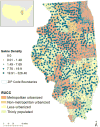Swine exposure and methicillin-resistant Staphylococcus aureus infection among hospitalized patients with skin and soft tissue infections in Illinois: A ZIP code-level analysis
- PMID: 28772149
- PMCID: PMC5862075
- DOI: 10.1016/j.envres.2017.07.037
Swine exposure and methicillin-resistant Staphylococcus aureus infection among hospitalized patients with skin and soft tissue infections in Illinois: A ZIP code-level analysis
Abstract
Background: Methicillin-resistant Staphylococcus aureus (MRSA), a bacterial pathogen, is a predominant cause of skin and soft tissue infections (SSTI) in the United States. Swine-production facilities have been recognized as potential environmental reservoirs of MRSA. To better understand how swine production may contribute to MRSA infection, we evaluated the association between MRSA infection among SSTI inpatients and exposure measures derived from national swine inventory data.
Methods: Based on adjusted odds ratios from logistic regression models, we evaluated the association between swine exposure metrics and MRSA infections among all Illinois inpatient hospitalizations for SSTI from January 2008 through July 2011. We also assessed if swine exposures had greater association with suspected community-onset MRSA (CO-MRSA) compared to suspected hospital-onset MRSA (HO-MRSA). Exposures were estimated using the Farm Location and Agricultural Production Simulator, generating the number of farms with greater than 1000 swine per residential ZIP code and the residential ZIP code-level swine density (swine/km2).
Results: For every increase in 100 swine/km2 within a residential ZIP code, the adjusted OR (aOR) for MRSA infection was 1.36 (95% CI: 1.28-1.45). For every additional large farm (i.e., >1000 swine) per ZIP code, the aOR for MRSA infection was 1.06 (95% CI: 1.04-1.07). The aOR for ZIP codes with any large farms compared to those with no large farms was 1.24 (95% CI: 1.19-1.29). We saw no evidence of an increased association for CO-MRSA compared to HO-MRSA with either continuous exposure metric (aORs=0.99), and observed inconsistent results across exposure categories.
Conclusions: These publicly-available, ecological exposure data demonstrated positive associations between swine exposure measures and individual-level MRSA infections among SSTI inpatients. Though it is difficult to draw definitive conclusions due to limitations of the data, these findings suggest that the risk of MRSA may increase based on indirect environmental exposure to swine production. Future research can address measurement error related to these data by improving exposure assessment precision, increased specification of MRSA strain, and better characterization of specific environmental exposure pathways.
Keywords: Antimicrobial resistance; Concentrated animal feeding operations (CAFOs); Methicillin-resistant Staphylococcus aureus (MRSA); Swine; Zoonosis.
Copyright © 2017 Elsevier Inc. All rights reserved.
Conflict of interest statement
There are no conflicts of interest to report.
Figures



Similar articles
-
Temporal trends of skin and soft tissue infections caused by methicillin-resistant Staphylococcus aureus in Gabon.Antimicrob Resist Infect Control. 2024 Jun 25;13(1):68. doi: 10.1186/s13756-024-01426-0. Antimicrob Resist Infect Control. 2024. PMID: 38918863 Free PMC article.
-
Risk factors associated with methicillin-resistant Staphylococcus aureus skin and soft tissue infections in hospitalized patients in Colombia.Int J Infect Dis. 2019 Oct;87:60-66. doi: 10.1016/j.ijid.2019.07.007. Epub 2019 Jul 19. Int J Infect Dis. 2019. PMID: 31330321
-
Methicillin resistant Staphylococcus Aureus in emergency department patients in the United Arab Emirates.BMC Emerg Med. 2018 May 15;18(1):12. doi: 10.1186/s12873-018-0164-7. BMC Emerg Med. 2018. PMID: 29764376 Free PMC article.
-
Staphylococcal resistance revisited: community-acquired methicillin resistant Staphylococcus aureus--an emerging problem for the management of skin and soft tissue infections.Curr Opin Infect Dis. 2003 Apr;16(2):103-24. doi: 10.1097/00001432-200304000-00007. Curr Opin Infect Dis. 2003. PMID: 12734443 Review.
-
Invasive community-associated MRSA infections: epidemiology and antimicrobial management.Expert Opin Pharmacother. 2010 Dec;11(18):3009-25. doi: 10.1517/14656566.2010.511614. Epub 2010 Oct 19. Expert Opin Pharmacother. 2010. PMID: 20955116 Review.
Cited by
-
Socioeconomic status and the risk for colonization or infection with priority bacterial pathogens: a global evidence map.medRxiv [Preprint]. 2024 Apr 24:2024.04.24.24306293. doi: 10.1101/2024.04.24.24306293. medRxiv. 2024. Update in: Lancet Microbe. 2025 Apr;6(4):100993. doi: 10.1016/j.lanmic.2024.100993. PMID: 38712194 Free PMC article. Updated. Preprint.
-
Association of distance to swine concentrated animal feeding operations with immune-mediated diseases: An exploratory gene-environment study.Environ Int. 2023 Jan;171:107687. doi: 10.1016/j.envint.2022.107687. Epub 2022 Dec 9. Environ Int. 2023. PMID: 36527873 Free PMC article.
-
Race, ethnicity and risk for colonisation and infection with key bacterial pathogens: a scoping review.BMJ Glob Health. 2025 Aug 7;10(8):e017404. doi: 10.1136/bmjgh-2024-017404. BMJ Glob Health. 2025. PMID: 40780833 Free PMC article.
-
Environmental Influences of High-Density Agricultural Animal Operation on Human Forearm Skin Microflora.Microorganisms. 2020 Sep 26;8(10):1481. doi: 10.3390/microorganisms8101481. Microorganisms. 2020. PMID: 32993188 Free PMC article.
-
Occurrence of Antibiotic-Resistant Staphylococcus spp. in Orange Orchards in Thailand.Int J Environ Res Public Health. 2021 Dec 27;19(1):246. doi: 10.3390/ijerph19010246. Int J Environ Res Public Health. 2021. PMID: 35010506 Free PMC article.
References
-
- Akwar TH, Poppe C, Wilson J, Reid-Smith RJ, Dyck M, Waddington J, Shang N, Dassie SA, McEwen SA. Risk factors for antimicrobial resistance among fecal Escherichia coli from residents on forty-three swine farms. Microb Drug Resist. 2007;13(1):69–76. http://doi.org/10.1089/mdr.2006.9999. - DOI - PubMed
-
- Bisdorff B, Scholhölter J, Claußen K, Pulz M, Nowak D, Radon K. MRSA-ST398 in livestock farmers and neighbouring residents in a rural area in Germany. BMC Proc. 2011;5(Suppl 6):P169. http://doi.org/10.1186/1753-6561-5-S6-P169. - DOI - PubMed
-
- Carrel M, Schweizer ML, Sarrazin MV, Smith TC, Perencevich EN. Residential proximity to large numbers of swine in feeding operations is associated with increased risk of methicillin-resistant Staphylococcus aureus colonization at time of hospital admission in rural Iowa veterans. Infect Control Hosp Epidemiol. 2014;35(2):190–192. http://doi.org/10.1086/674860. - DOI - PubMed
-
- Casey JA, Cosgrove SE, Stewart WF, Pollak J, Schwartz BS. A population-based study of the epidemiology and clinical features of methicillin-resistant Staphylococcus aureus infection in Pennsylvania, 2001–2010. Epidemiol Infect. 2012;141(6):1166–1179. http://doi.org/10.1017/S0950268812001872. - DOI - PMC - PubMed
MeSH terms
Grants and funding
LinkOut - more resources
Full Text Sources
Other Literature Sources
Medical

